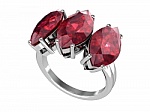AGS Diamond Grading: What You Need To Know About Diamond Grades

 The AGS or American Gem Society has a clear method grading gems, particularly diamonds, based on their quality. Unfortunately, many jewelry buyers do not understand how these scales work, holding only a general idea that “flawless” ratings are good and “included” is bad. The primary AGS scales go far deeper than this, and can offer even the casual jewelry shopper a wealth of information on the gem and its official quality.
The AGS or American Gem Society has a clear method grading gems, particularly diamonds, based on their quality. Unfortunately, many jewelry buyers do not understand how these scales work, holding only a general idea that “flawless” ratings are good and “included” is bad. The primary AGS scales go far deeper than this, and can offer even the casual jewelry shopper a wealth of information on the gem and its official quality.
The AGS references three different scales when grade gems – clarity, color, and cut. Here are the basics behind each scale and what the numeral grade means. Watch for these grades the next time you peruse jewelry to make the best choice:
The Clarity scale offers a grade for diamond clarity, and is one of the most useful measurements when judging diamond quality. The clearer the diamond, the more “pure” it will look to the naked eye and the fewer blemishes it will have. This helps the light refract more accurately based on the cut. Jewelers study the size, nature, location, and number of inclusions in diamonds before giving them an official grade.
The Clarity Scale goes from 0 to 10, and provides a more detailed grade than GIA descriptions like “flawless.” A diamond rated 0 is completely flawless, while those in the 1-2 range are “very, very slightly included” with flaws that barely even visible under close inspection. Diamonds rated 3 or 4 are have slightly more obvious inclusions and so forth, until diamonds graded 7 through 10 are officially “included” although they may have varying levels of quality based on their specific numerical grade. Only a skilled grade used the right tools in the right environment can pinpoint these grades.
At first glance, you may not think the color grades apply to diamonds, but diamonds can come in many different shades naturally, varying from utterly clear to yellow in tone or “fancy yellow.” Jewelers prefer to look at unmounted jewels to create an accurate color grade so that no nearby metals influence the coloring. While traditional analysis uses an odd letter-based system to judge color, the AGS uses another 0 – 10 scale.
Again, 0 in this case is utterly perfect and colorless. However, because of the various gradients in color numbers on this scale creep up to 0.5 and then to 1 – both also considered colorless but slightly less than perfect. The grades 1.5 through 3 are judged near colorless, while grades 3.5 through 4.5 are called “faint,” showing a tinge of color. The last half of the scale is divided more broadly between “very light” and “light” grades showing just how yellow a diamond is. Generally diamonds past 7 clearly look yellow, and behind the scale are a number of “fancy yellow” colors that do not make the grade.
The AGS diamond cut grade shows how well a diamond is cut. This does NOT judge if one cut is better than another cut. Cuts vary widely based on buyer preference and other factors. However, the scale does show the quality of the cut, which is helpful when comparing diamonds that have similar cuts.
Like the other scales, 0 – 10 is the range here, and 0 still stands for the “ideal,” perfect cut, which are often priced higher than diamonds graded slightly below at a 1 rating, which bumps the cut down to “excellent.” A 2 rating is only “very good,” but after this the split is broader. Diamonds with a 3 and 4 cut are both “good,” while a 5 through 7 wins a “fair.” Beyond that, however, the rating falls to “poor.”
Article written by jewelry copywriter and blogger Alice Galert – author of Whiteflash, JamesAllen, Since1910 and BlueNile reviews at diamondstoresreviews.com.
